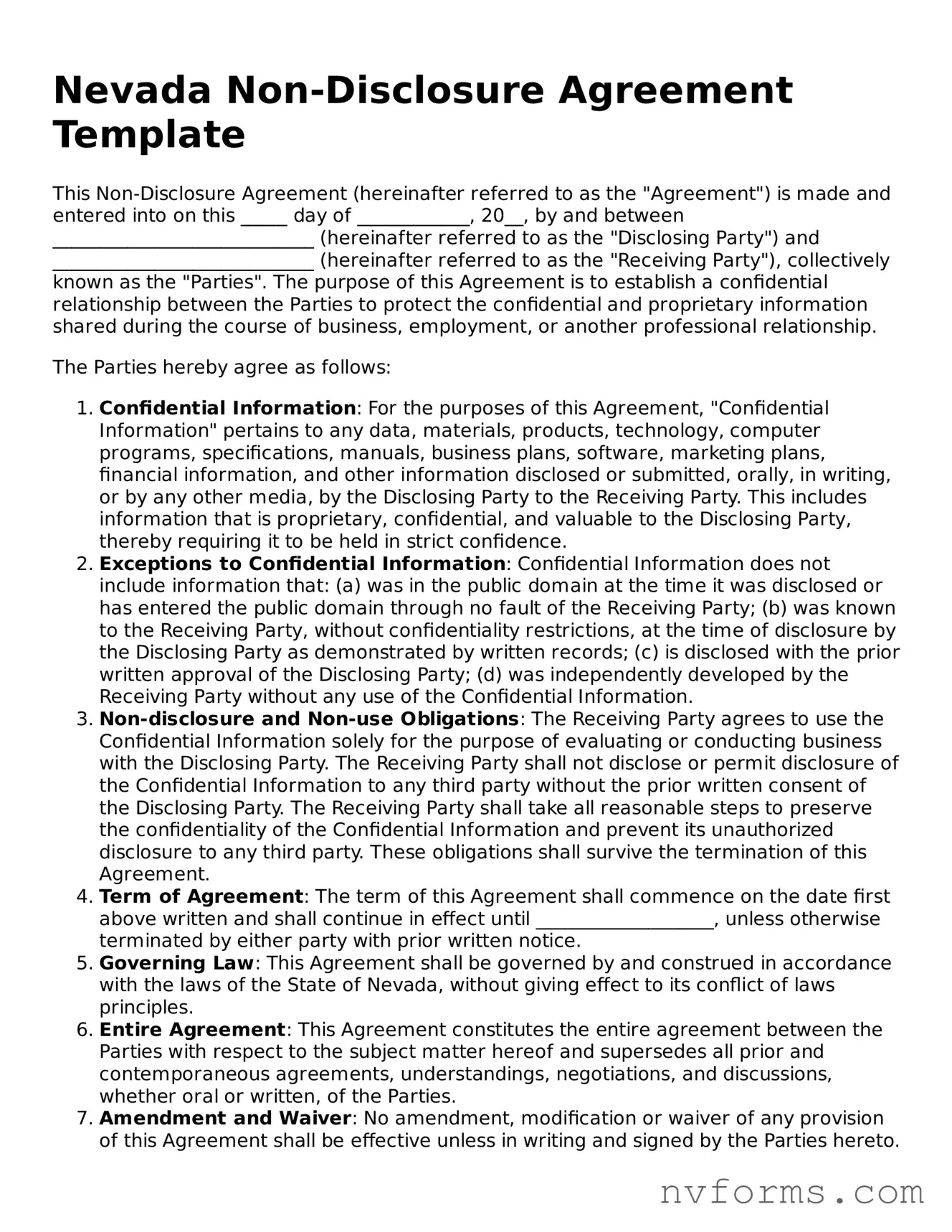Nevada Non-Disclosure Agreement Template
This Non-Disclosure Agreement (hereinafter referred to as the "Agreement") is made and entered into on this _____ day of ____________, 20__, by and between ____________________________ (hereinafter referred to as the "Disclosing Party") and ____________________________ (hereinafter referred to as the "Receiving Party"), collectively known as the "Parties". The purpose of this Agreement is to establish a confidential relationship between the Parties to protect the confidential and proprietary information shared during the course of business, employment, or another professional relationship.
The Parties hereby agree as follows:
- Confidential Information: For the purposes of this Agreement, "Confidential Information" pertains to any data, materials, products, technology, computer programs, specifications, manuals, business plans, software, marketing plans, financial information, and other information disclosed or submitted, orally, in writing, or by any other media, by the Disclosing Party to the Receiving Party. This includes information that is proprietary, confidential, and valuable to the Disclosing Party, thereby requiring it to be held in strict confidence.
- Exceptions to Confidential Information: Confidential Information does not include information that: (a) was in the public domain at the time it was disclosed or has entered the public domain through no fault of the Receiving Party; (b) was known to the Receiving Party, without confidentiality restrictions, at the time of disclosure by the Disclosing Party as demonstrated by written records; (c) is disclosed with the prior written approval of the Disclosing Party; (d) was independently developed by the Receiving Party without any use of the Confidential Information.
- Non-disclosure and Non-use Obligations: The Receiving Party agrees to use the Confidential Information solely for the purpose of evaluating or conducting business with the Disclosing Party. The Receiving Party shall not disclose or permit disclosure of the Confidential Information to any third party without the prior written consent of the Disclosing Party. The Receiving Party shall take all reasonable steps to preserve the confidentiality of the Confidential Information and prevent its unauthorized disclosure to any third party. These obligations shall survive the termination of this Agreement.
- Term of Agreement: The term of this Agreement shall commence on the date first above written and shall continue in effect until ___________________, unless otherwise terminated by either party with prior written notice.
- Governing Law: This Agreement shall be governed by and construed in accordance with the laws of the State of Nevada, without giving effect to its conflict of laws principles.
- Entire Agreement: This Agreement constitutes the entire agreement between the Parties with respect to the subject matter hereof and supersedes all prior and contemporaneous agreements, understandings, negotiations, and discussions, whether oral or written, of the Parties.
- Amendment and Waiver: No amendment, modification or waiver of any provision of this Agreement shall be effective unless in writing and signed by the Parties hereto.
- Signature: IN WITNESS WHEREOF, the Parties hereto have executed this Non-Disclosure Agreement as of the date first above written.
Disclosing Party: _________________________________________________
Receiving Party: __________________________________________________
Date: ____________________________________________________________
